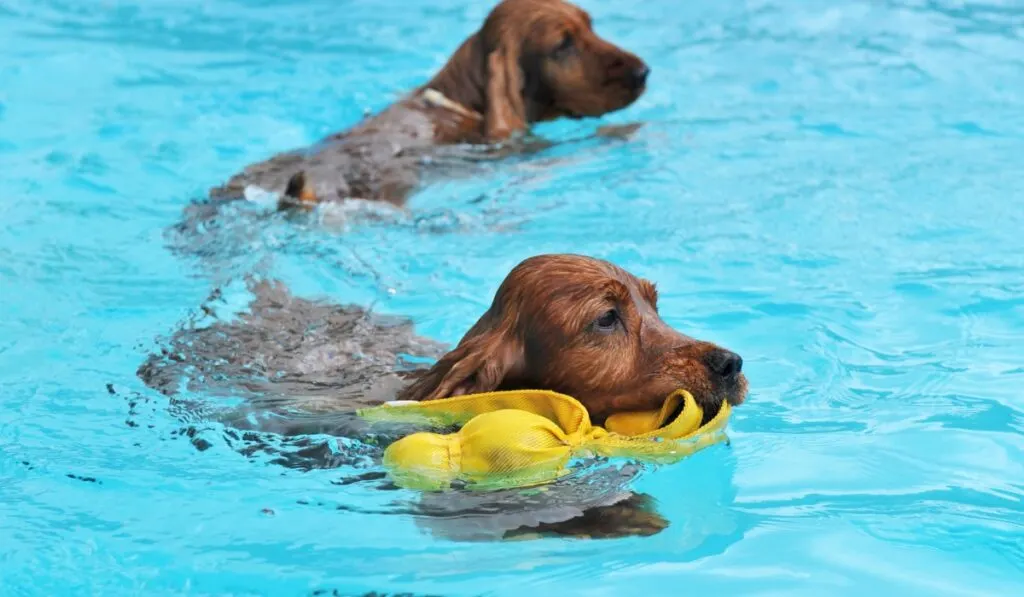Are webbed feet reserved only for ducks and other aquatic mammals?
Many cocker spaniels are excellent swimmers, and observative owners have probably seen some degree of webbing inbetween the toes… So let’s get to the bottom of this!
The short answer is yes, Cocker Spaniels do have webbed feet. However, the extent to which their feet are webbed varies from dog to dog.
In this article, I will explain what webbed feet are, why Cocker Spaniels have them, and how this characteristic benefits them.

What Are Webbed Feet?
Webbed feet, also known as palmate feet, are feet that have skin folds, or webbing, between the toes.
The webbing helps to distribute a dog’s weight evenly on soft surfaces such as sand, snow, or marshy land.
This feature also helps dogs to swim efficiently by increasing the surface area of the paws and providing better traction in water.
Can Dogs Even Have Webbed Feet?
Yes, dogs can have webbed feet. In fact, many dog breeds have some degree of webbing between their toes, although the amount and thickness of the webbing can vary from breed to breed.
This webbing is formed by a membrane of skin that connects the toes, and it provides a number of benefits for dogs that are especially active in the water or on wet surfaces.
The presence of webbed feet in dogs is a natural and evolutionary adaptation that has developed over time to help dogs perform certain tasks.
For example, water dogs and retrievers, such as Labrador Retrievers and Golden Retrievers, have webbed feet that help them swim more efficiently, making them excellent hunting and retrieving dogs.
Similarly, breeds like the Newfoundland and Portuguese Water Dog, which were bred for water rescue work, have particularly large and well-developed webbed feet that allow them to swim long distances with ease.
Even non-water dogs, such as the Cocker Spaniel, can have webbed feet to some degree. In these breeds, the webbing between the toes is typically less pronounced, but it can still provide benefits such as better balance and improved traction on slippery surfaces.
It is important to note, however, that not all dog breeds have webbed feet. For example, many small dog breeds, such as Chihuahuas and Pomeranians, do not have webbing between their toes. This is likely because these breeds were not developed for activities that require strong swimming or traction on wet surfaces.

15 Dog Breeds With Noticeable Webbing
While many dog breeds have some degree of webbed feet, some breeds are more well-known for this characteristic than others. Here are the top 15 breeds that have the most significant webbed feet (cocker spaniel makes the list!)
- Newfoundland
- Labrador Retriever
- Golden Retriever
- Portuguese Water Dog
- Irish Water Spaniel
- Chesapeake Bay Retriever
- Otterhound
- American Water Spaniel
- Flat-Coated Retriever
- Curly-Coated Retriever
- Nova Scotia Duck Tolling Retriever
- Spanish Water Dog
- Landseer
- Leonberger
- Cocker Spaniel
Why Do Cocker Spaniels Have Webbed Feet?
Cocker Spaniels were originally bred to be hunting dogs. They were trained to retrieve birds from water and to flush game birds from the underbrush.
Their webbed feet made them excellent swimmers and allowed them to traverse marshy terrain with ease. As a result, Cocker Spaniels were highly prized by hunters.
Today, Cocker Spaniels are more commonly kept as family pets than as hunting dogs, but their webbed feet remain an important characteristic of the breed.
This feature allows them to enjoy swimming and playing in the water, and it can also help them to stay afloat if they accidentally fall into a pool or other body of water.
Benefits of Webbed Feet For Cocker Spaniels
Webbed feet provide several benefits for Cocker Spaniels.
Here are some of the most important ones:
- Swimming: As mentioned earlier, Cocker Spaniels are natural swimmers. Their webbed feet enable them to paddle through the water more efficiently, making it easier for them to swim for longer periods without getting tired.
- Traction: The webbing between a Cocker Spaniel’s toes provides extra traction on wet surfaces. This helps them to walk on slippery floors or rocks, which can be especially helpful when hiking or playing near water.
- Better Balance: The webbing on their feet also helps Cocker Spaniels to maintain their balance. This is particularly useful when they are running or jumping, as it allows them to land more securely on their feet.
- Protection: The webbing between the toes can help to protect Cocker Spaniels’ feet from cuts, scrapes, and other injuries when running through rough terrain.
Caring for Cocker Spaniels Feet
Although Cocker Spaniels’ webbed feet are a natural characteristic of the breed, it is still important to take care of them to ensure your dog’s optimal health and well-being. Here are some tips on how to care for your Cocker Spaniel’s webbed feet:
- Keep them Clean: Regularly clean your Cocker Spaniel’s feet with a damp cloth to remove dirt and debris that can accumulate between the toes.
- Keep them Dry: Dry your dog’s feet thoroughly after they have been in the water to prevent infections or other foot problems.
- Trim the Fur: Trim the fur between your Cocker Spaniel’s toes to prevent matting and to keep the webbing visible.
- Check for Injuries: Check your dog’s feet regularly for cuts, scrapes, or other injuries. If you notice any problems, take your dog to the veterinarian for treatment.
Last Thoughts
In conclusion, Cocker Spaniels do have webbed albeit minimally, which is a natural characteristic of the breed.
This feature provides many benefits for these dogs, including better swimming ability, improved traction on wet surfaces, better balance, and protection against injuries. As a Cocker Spaniel owner, it is important to care for your dog’s feet by keeping them clean and dry, trimming the fur between the toes, and checking for any injuries.
